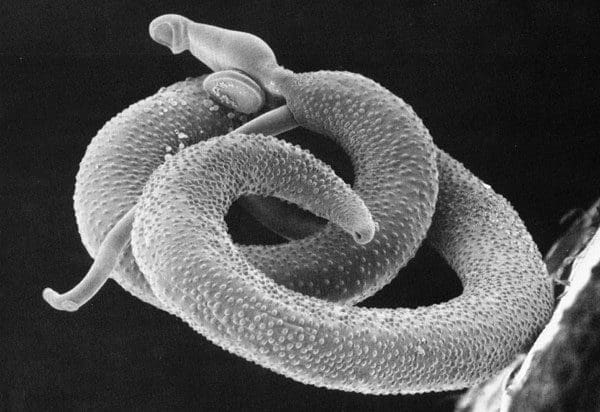
One of the most interesting genre in the field of parasitology is the flukes, and the blood fluke Schistosoma holds a special place. It has a riveting history and a fascinating life cycle, making it one of the most alluring among the parasitic worms.
From Lake to Claret: An Epic Journey
It all begins when the tiny fluke eggs are released into the freedom of a freshwater from the confines of the salty human pee. There the eggs hatch, releasing the hairy, free-swimming larvae, known as the miracidia. They then penetrate the body of an unsuspecting snail, inside which they grow silently and come out as the fork tailed cercariae. They keep swimming, up and down the lake, in wait for the last, but most difficult and important part of their journey – human body. Finally, when they meet the skin of a person swimming or waddling, they lose their tail, form little schistosomes, drill through the skin, pass through lymph or blood and reach liver. There they take shelter for 2–3 weeks, growing in the safe confinement of portal blood, in disguise of host antigen, avoiding the army of human immunity. 
Once they are grown and ready, they leave liver, their journey bound to intestine or the urinary bladder, traveling against the bloody deluge of portal circulation, seeking their destination – the warm, cozy venous plexus of the urinary bladder. There they mate, lay their eggs and die, fulfilling their duty, after an arduous journey of life. The eggs burrow through the thick muscle of the bladder wall, striving for freedom, finally coming out into urine and getting out into the bigger world, and the cycle of life continues.

We people think our lives are difficult; just think about the endeavour these little worms went through for survival.
The Katayama fever and Other Diseases
Once found, the human immunity acts vigorously against the parasites leading to a wide array of diseases. It starts when the worm passes through skin, where allergy to the schistosome leads to swimmer’s itch. Once they enter blood and travel to various organs, systemic response mounted leads to the classic Katayama fever.
Over time, body tries to control the parasite’s invasion – some of the eggs trying to get out are trapped in the bladder muscle, constrained and killed by the calcific walls built by the immune system. One of the most common features is passage of bloody urine due to injury to bladder. They can also travel to many of the organs causing a variety of symptoms.

They are also known to cause cancers.
The Discovery
It was 1851. Theodor Bilharz, a German physician, who came to Egypt with his master, was working in hospital in Cairo. During one of his autopsies, he discovered the worm that had caused a lot of problems around the region. It was later named after him as Bilharzia. Though it later became Schistosoma, the split-body worm, describing the male worm, his contribution is forever remembered. Sadly, he died at a young age of 37 after contracting typhus disease.
The Tiny Worm that beat the Mighty Emperor
It was in late 18th century when French monarch Napoleon invaded Egypt. That was the time when he went on conquering kingdoms after kingdoms, becoming the ‘unbeatable’. But Egypt was different. It was not the big, armed Egyptian soldiers he had to worry about; it was those tiny, bloody mongrels in the river Nile, waiting for the warm human meat.
Days after his troops marched Nile, his soldiers started pissing blood. They were terror-stricken by what they thought to be the Pharaoh’s curse causing ‘male menstruation’. At a great cost to his army, the mighty Napoleon had to finally step back. The tiny worms had done what huge armies could not.
To conclude…
In a harsh, tough world, it is not the size that matters. It is the will to survive, it is what you will do to live, to achieve. If anyone has proved that, it is the tiny flat worms, through their survival against all odds, standing the test of time. It is truly a motivation for us humans, to try and do what we have to.
About the Author: Keshava Pavan is a final year MBBS student at the Kasturba Medical College, Mangalore.
We accept guest articles that are interesting and that are upto 800 words in length. If you want to contribute, send them to [email protected].

Be the first to comment